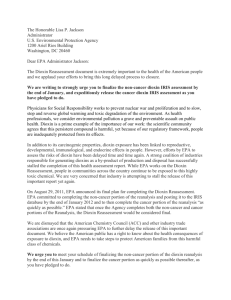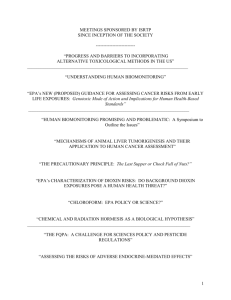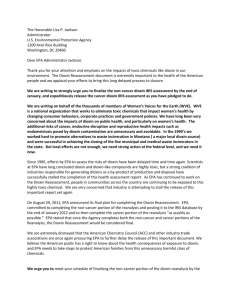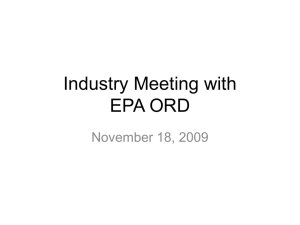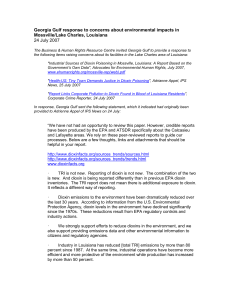Greenpeace
advertisement
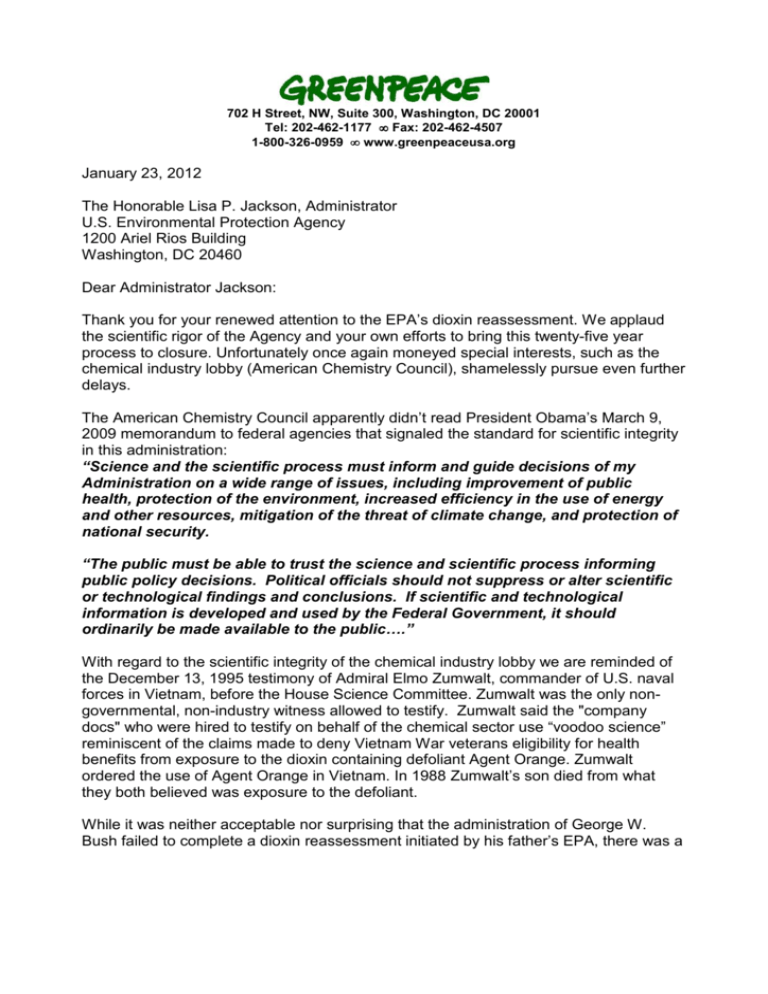
702 H Street, NW, Suite 300, Washington, DC 20001 Tel: 202-462-1177 • Fax: 202-462-4507 1-800-326-0959 • www.greenpeaceusa.org January 23, 2012 The Honorable Lisa P. Jackson, Administrator U.S. Environmental Protection Agency 1200 Ariel Rios Building Washington, DC 20460 Dear Administrator Jackson: Thank you for your renewed attention to the EPA’s dioxin reassessment. We applaud the scientific rigor of the Agency and your own efforts to bring this twenty-five year process to closure. Unfortunately once again moneyed special interests, such as the chemical industry lobby (American Chemistry Council), shamelessly pursue even further delays. The American Chemistry Council apparently didn’t read President Obama’s March 9, 2009 memorandum to federal agencies that signaled the standard for scientific integrity in this administration: “Science and the scientific process must inform and guide decisions of my Administration on a wide range of issues, including improvement of public health, protection of the environment, increased efficiency in the use of energy and other resources, mitigation of the threat of climate change, and protection of national security. “The public must be able to trust the science and scientific process informing public policy decisions. Political officials should not suppress or alter scientific or technological findings and conclusions. If scientific and technological information is developed and used by the Federal Government, it should ordinarily be made available to the public….” With regard to the scientific integrity of the chemical industry lobby we are reminded of the December 13, 1995 testimony of Admiral Elmo Zumwalt, commander of U.S. naval forces in Vietnam, before the House Science Committee. Zumwalt was the only nongovernmental, non-industry witness allowed to testify. Zumwalt said the "company docs" who were hired to testify on behalf of the chemical sector use “voodoo science” reminiscent of the claims made to deny Vietnam War veterans eligibility for health benefits from exposure to the dioxin containing defoliant Agent Orange. Zumwalt ordered the use of Agent Orange in Vietnam. In 1988 Zumwalt’s son died from what they both believed was exposure to the defoliant. While it was neither acceptable nor surprising that the administration of George W. Bush failed to complete a dioxin reassessment initiated by his father’s EPA, there was a moment in time even then when it looked promising. On June 2, 2001 the Washington Post reported: “An expert scientific panel formally urged the Environmental Protection Agency yesterday to release a study that has been in the works for more than a decade and concludes that consumption of animal fat and dairy products containing traces of dioxin can cause cancer in humans. “The study's conclusion that chlorinated dioxin is an air pollutant that should be more tightly regulated could have serious long-term economic consequences for a wide variety of industries, including producers of milk, beef, poultry, and chemical and paper products. The EPA's issuance of a final report could result in federal and state regulations costly to those industries. “EPA scientists and officials have said they are confident of the findings, which they began circulating last June, and are urging EPA Administrator Christine Todd Whitman to issue it in final form this summer. But the study is politically charged and has drawn opposition from industry groups and Capitol Hill Republicans. “A spokesman for Whitman said yesterday that a final decision will be put off until other agencies, including the Agriculture Department, the Food and Drug Administration and the Justice Department, have an opportunity to review the study.” In an August 2, 2001 letter to EPA Administrator Christine Todd Whitman, over forty members of Congress said: “The American people have already waited a long time–more than ten years–for the completion and release of the Dioxin Reassessment. EPA has been studying the sources and health effects of dioxin for nearly 20 years, and this report is the most comprehensive health risk assessment ever prepared by the agency. “The Dioxin Reassessment finds that dioxin causes a wide array of adverse health effects. The risk of cancer from dioxin exposure may exceed one in 1000 for the general population—a level a thousand times higher than the risk level of one in a million that is generally considered acceptable for cancer. The risk is higher for workers and others with higher levels of exposure. Dioxin also causes numerous non-cancer health problems, including reproductive, immunological, developmental, and endocrine system effects… “By signing the Stockholm Convention on Persistent Organic Pollutants this spring, the Administration officially recognized that dioxin is hazardous. Parties to the treaty are committed to a number of significant steps to eliminate or reduce the production, use and release of 12 persistent organic pollutants (POPs), including dioxin. While recognizing that it will be a challenge to completely eliminate dioxin, since it is a by-product of industrial activities, the treaty calls for its “continuing minimization and where feasible, ultimate elimination. Given U.S. 2 support for the POPs treaty, it is imperative that we move ahead with the Dioxin Reassessment, which will provide a basis for domestic policies on dioxin.” As a result of these inexcusable delays we certainly do not take your efforts today for granted. In fact we are reminded of a similar time during the Clinton administration when we thought the conclusion of the dioxin reassessment was at hand. Below is an excerpt from the testimony of Greenpeace Research Coordinator, Joseph Thornton, before the EPA Science Advisory Board on May 15, 1995. (In 2007 President Bush awarded Mr. Thornton the Presidential Early Career Award for Scientists and Engineers for his work in evolutionary biology.) “Until the release of the 1994 reassessment, the history of EPA's science on dioxin was stained by political tampering. When EPA last tried to reassess the hazards of dioxin, in 1987, it was clear to all that the process was driven by a political agenda for deregulation, although the document that emerged masqueraded as science or, even worse, so-called ‘science-policy.’ Only after the SAB rejected that reassessment did EPA withdraw its proposal to downgrade its estimate of dioxin's toxicity. After that, the record shows that the paper and chemical Industries redoubled their lobbying effort to persuade EPA and the Bush White House to revise the dioxin hazard assessment once again. When the agency responded by announcing the reassessment in 1991, we expected that this project, like the one before it, would be designed to yield a predetermined outcome in the interest of polluting industries. “It is thus with great surprise and sincerity that we congratulate the scientists in EPA for their integrity in the preparation of the documents released in September. EPA built in accountability and transparency by involving external authors and expert review panels, publishing parts of the reassessment in scientific journals prior to government publication, and holding public hearings on the document. “EPA thus raised the public's expectations tremendously. This document has garnered worldwide attention and has catalyzed recognition of the long-term health impacts of large-scale dioxin pollution. It has created a flurry of activity to eliminate dioxin sources among grassroots communities in this country, many of whom feel EPA has told them the truth for the first time. The world is eagerly awaiting EPA's final commitment to the vision contained in the draft reassessment. “As we expected, however, the draft reassessment provoked an aggressive counter-offensive by dioxin-producing industries. Much of this effort, supported by tremendous financial resources, you will see before you in the next two days. Now the ball is in the SAB's court: the panel must help to clarify the scientific basis of the message, but it must not shy from or cloud the truth. If at this point the SAB allows or forces EPA to retreat in the face of political pressure, it will do tremendous damage to the credibility not just of EPA but of scientists in our society in general. If EPA retreats now from its position, everyone will know that 3 the agency started to tell the truth, but powerful political interests ultimately silenced this voice, all under the guise of ‘scientific review.’ The public's trust in the integrity of science, currently at an all-time low, will erode further. “Ultimately, the greatest cost will be the health of future generations. The reassessment and its review are not your average government toxicology project. At stake are issues that pertain to the integrity of the human species -- and many others, as well -- on a global basis. At stake is our ability to produce children who can develop normally and live full and healthy lives in a world in which other species are also healthy; you are on this panel as leading scientists, but we hope you will not forget your roles as parents, grandparents, and guardians of the planet. To its credit, EPA has assumed a leadership role in the dioxin debate. We thank you for showing courage, clarity and integrity as you address these profound issues.” As you know, on August 29, 2011, the EPA announced its plan for the completion of the dioxin reassessment. EPA committed to completing the non-cancer portion of the reanalysis and posting it to the IRIS database by the end of January 2012 and to then complete the cancer portion of the reanalysis “as quickly as possible.” EPA stated that once the Agency completes both the non-cancer and cancer portions of the reanalysis, the reassessment would be considered final. The American public has a right to know about the health consequences of exposure to dioxin, and EPA needs to take steps to protect American families from this unnecessary harmful class of chemicals. We urge you to adhere to your stated schedule of finalizing the non-cancer portion of the dioxin reanalysis by the end of January 2012 and to finalize the cancer portion as quickly as possible thereafter. Thank you for your attention to this matter, and for your commitment to protecting America’s health and environment. Sincerely, Rick Hind Legislative Director Greenpeace cc: Cass Sunstein, Administrator, Office of Information and Regulatory Affairs Nancy Sutley, Chair, White House Council on Environmental Quality (CEQ) Paul Anastas, Assistant Administrator, Office of Research and Development, EPA Rebecca Clark, Acting Director, National Center for Environmental Assessment 4
